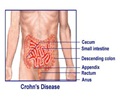Huge and somewhat puzzling interstate variations in the percentage of emergency versus elective bowel surgeries were documented by Johns Hopkins researchers.

Reporting details of their findings in the May issue of the Journal of Trauma and Acute Care Surgery, Haider's team found, for example, that people having part of their colon removed in Nevada required emergency surgery half the time, while in Texas, only 22 percent did. After Nevada, the states with the highest percentage of emergency surgery cases include North Carolina, Utah, New Jersey, Montana and West Virginia. After Texas, the states with the lowest percentage of emergency surgery cases are New Mexico, Washington, South Dakota, Kansas, Minnesota and Wyoming.
Haider says that identifying such interstate variations for colon surgeries suggests there may be a way to decrease the rates of emergency procedures by analyzing potentially contributing factors. Part of the colon may be removed because of cancer or a number of other diseases.
"If one state or region can do a procedure more safely, more cost-effectively or with better outcomes, others can learn from and emulate it," Haider says. "Whether these differences occur on a practitioner level, institutional level, regional level or otherwise, we don't yet know, but it is essential that we identify and address them."
In their study, Haider and his colleagues analyzed hospital discharge data from the 2005 to 2009 Nationwide Inpatient Sample, identifying 203,050 patients older than 18 who underwent surgery, either electively or emergently, to remove part of the colon. The data came from 44 states. Overall, 59 percent of patients had elective surgery while 41 percent underwent emergency procedures.
Geography, population makeup or regional trends did not appear to play a role in the differences. Montana and Wyoming, for example, share a border, but have among the highest and lowest rates of emergency colectomy, respectively. Similarly, New Mexico and Nevada, both of which are located in the southwest and may theoretically share a similar population, have vastly different rates.
Advertisement
Haider says worse outcomes following emergency surgery are typically related to the severity of the patient's condition upon arrival in the operating room. The disease may be far more advanced. The patient's other health conditions may not be in check. There may be complications due to the rupturing of the intestines that increase infection risk.
Advertisement
Source-Eurekalert












